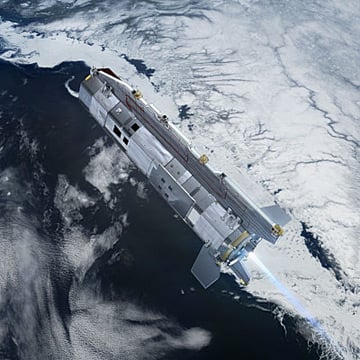This article is more than 1 year old
Falkland Islands almost BLITZED from space by plunging European ion-rocket craft
Sheep may safely graze
Updated The European Space Agency (ESA) has kindly let the planet know that the Gravity field and steady-state Ocean Circulation Explorer – GOCE – has re-entered earth's atmosphere, apparently without incident.

GOCE during its mission
The demise of the craft was expected, because it ran out of fuel in October: GOCE was required to orbit especially low for its mission, and despite being a streamlined dart (unlike most satellites) it needed continual thrust from its pair of ion rockets to maintain orbital velocity against the drag of the wispy upper atmosphere.
The ESA - whose boffins have been known to refer to the GOCE as a "Ferrari" among spacecraft - did at least offer estimates of "a re-entry time window between 22:50 UTC on 10 November and 00:50 UTC on 11 November (23:50-01:50 CET)" and suggest "The most probable re-entry area lies on a descending orbit pass that mainly runs across the Pacific and the Indian Ocean."
In other words, somewhere on about half the surface of the world, albeit the most watery bits.
Complicating matters further for the nervous, the New York Times speculated that 100-pound bits of GOCE could rain down on us all.
The ESA crew blogging GOCE's demise helpfully went to bed before the satellite re-entered, but didn't tuck themselves in without promising a press release would be emitted once something about the satellite's fate was known.
Thankfully that press release has been issued and offered the following reassuring message:
"Close to 01:00 CET on Monday 11 November, ESA’s GOCE satellite reentered Earth’s atmosphere on a descending orbit pass that extended across Siberia, the western Pacific Ocean, the eastern Indian Ocean and Antarctica. As expected, the satellite disintegrated in the high atmosphere and no damage to property has been reported."
As we've noted, however, the locales mentioned above represent a jolly big chunk of Earth's surface. Just how the ESA can guarantee no property damage mere hours after GOCE re-entered the atmosphere is anyone's guess, especially as someone dealing with a red-hot chunk of satellite in their locale is unlikely to be in a position to phone in the news.
The Reg will therefore update this story again if news of just where GOCE came to grief comes to hand, although as our Sydney office borders the Pacific Ocean you can take a lack of any further news of any sort to mean the ESA got this one very badly wrong.
Incidentally, the bird cost $470m if you include its launcher and operations in that price tag. ®
Updated to Add
The ESA has now relayed US Strategic Command space tracking data which shows that any surviving bits of GOCE will have plunged into the South Atlantic not far from the Falkland Islands.
